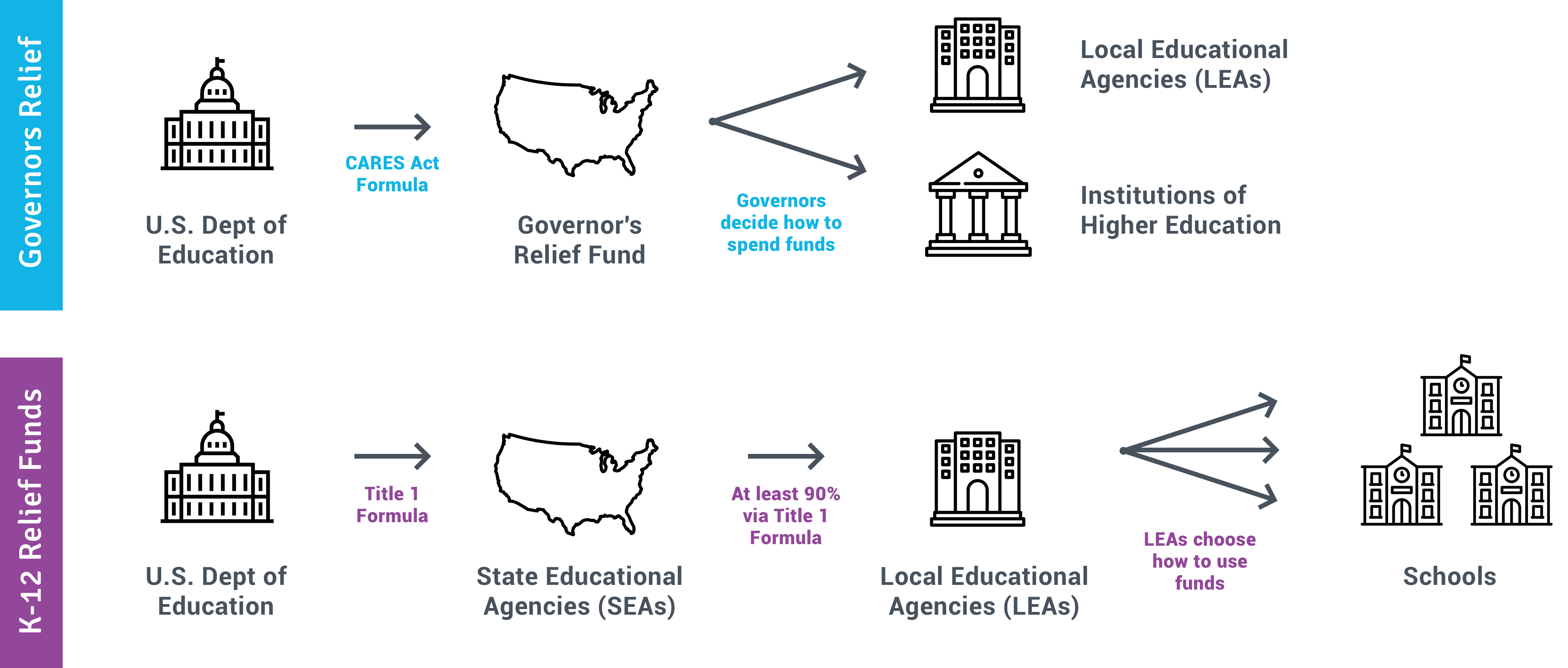Federal Funding FAQs
This fund provides $13.2 billion to be awarded to SEAs for the purpose of providing LEAs, including charter schools that are LEAs, with emergency relief funds to address the impact that COVID-19 has had, and continues to have, on elementary and secondary schools across the nation.
Additional Details:
- States will receive this funding based on the number of students in poverty in the same manner as funding is provided under Title I, Part A.
- States must allocate 90 percent of that funding to districts, including charter schools, based on Title I, Part A.
- Districts have flexibility on how to target the funds they receive, including how and which schools are funded.
- States have flexibility on how to target the 10 percent of funding they retain. One way to think about this funding is that it equates to about 80 percent of the most recent year’s Title I, Part A, funding.
If you have questions about the ESSER Fund: esserf@ed.gov
This fund provides $3 billion for grants to states based on a formula stipulated in the legislation. (1) 60% on the basis of the State’s relative population of individuals aged 5 through 24. (2) 40% on the basis of the State’s relative number of children counted under section 1124(c) of the Elementary and Secondary Education Act of 1965 (ESEA).
Additional Details:
- States will receive funds based on a combination of both school-age population and rates of poverty.
- Governors have wide discretion over use of these funds to support K-12 or higher education.
If you have questions about the GEER Fund: geerf@ed.gov
This fund provides support to SEAs in States with the highest coronavirus burden to address specific educational needs of students, their caregivers, and teachers in public and non-public elementary and secondary schools in accordance with section 18001(a)(3) of the CARES Act.
Additional Details:
- Request a waiver on the 15% carryover limitation for Title I, Part A.
- Obtain an extension on availability for the prior fiscal year’s funds.
- Receive a waiver of the needs assessment, content-specific spending requirements, and spending restrictions on technology infrastructure under Title IV, Part A.
- Request a waiver of the definition of “professional development” in order to prevent limitations on the ability to quickly train school leaders and teachers on topics like effective distance learning techniques.
If you have questions about the ESF-REM Fund: esf-rem@ed.gov
The CARES Act provides approximately $31 billion in emergency education funding to students, schools, institutions, and states across the country. $13 billion in support goes to school districts.This funding would cover a wide range of activities, including cleaning and sanitizing schools, purchasing educational technology such as laptops and hotspot devices, training educators to use online learning tools, ensuring access to education for students with disabilities, and providing students emergency funding for food, housing, and other basic essentials. $14 billion in support goes to institutions of higher education. This funding gives direct financial relief to institutions of higher education struggling to make up for lost revenue following school closures and requires that institutions spend some of that funding on emergency financial aid grants to students. Another $3 billion will go to governors for emergency education relief that can be spent on school districts, institutions of higher education, or both.
For the Governor’s Relief Fund, governors will have wide discretion in how they spend funds to support K-12 and higher education. However, for the K-12 Relief Fund, states must distribute at least 90% to districts to determine how to best spend the funds. States will receive this funding based on the number of students in poverty in the same manner as funding is provided under Title I, Part A.The chart below shows how the funds are distributed from the U.S. Department of Education to the schools.

SEAs must award funds within one year of receiving funds from the U.S. Department of Education. The initial award period is from March 13, 2020 through June 30, 2021 and LEAs have until September 30, 2022 toexpend funds.
The CARES Act includes a long list of allowable activities, including any activities authorized under a range of existing federal education laws, as well as a long list of activities broadly related tocoronavirus, such as support for principals and other school leaders to meet the needs of their schools; support for education technology essential to distance learning; and support for measures to address the unique needs of low-income students, children with disabilities, English learners, racial and ethnic minorities, students experiencing homelessness and foster care youth. Also on the list is support for summer learning and afterschool programs.
Full Set of Allowable Activities
- Any activities authorized by ESSA, IDEA, the Adult Education and Family Literacy Act, the Perkins Career and Technical Education Act, and the McKinney-Vento Homeless Assistance Act (as related to education programs for homeless children and youth)
- Activities to address the unique needs of low-income students, children with disabilities, English learners, racial and ethnic minorities, students experiencing homelessness, and foster care youth
- Coordination in response to the Coronavirus
- Resource for principals and school leaders to meet the needs of their schools
- Designing and implementing procedures and systems to improve preparedness and response efforts
- Training and professional learning on sanitation and minimizing infectious diseases
- Purchasing supplies to clean and sanitize
- Planning for and coordinating during long-term closures, such as providing meals to students, providing online learning to all students, and providing guidance on carrying out IDEA requirements
- Purchasing education technology for students
- Providing mental health services
- Planning and implementing summer learning and after-school programs
- Continuing to employ existing staff
- Other activities to maintain operations and continue services


